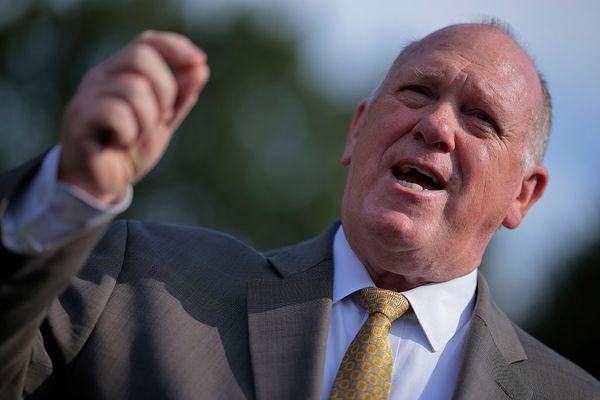
The Federal Reserve raised interest rates once again on Wednesday, as concerns about persistently elevated inflation trumped turmoil in the banking industry.
The central bank's rate-setting group, known as the Federal Open Market Committee (FOMC), wrapped up its regularly scheduled two-day meeting by increasing the short-term federal funds rate by 25 basis points, or 0.25%.
Wednesday's quarter-point hike represented a continuation of policy from the Fed's February confab, in which it also hiked interest rates by a quarter of a percentage point.
To recap: February's rate hike represented a further step in easing amid the most hawkish course of monetary policy since the late Carter and early Reagan administrations. In December, the Fed enacted an increase of 0.50%, which was the first step in easing after a historic run of rate increases. Prior to the December meeting, the FOMC raised short-term rates at an unprecedented pace, hiking by 75 basis points for four consecutive meetings.
The sudden and shocking collapses of Silicon Valley Bank, Signature Bank, Credit Suisse (CS) and First Republic Bank (FRC) led to calls for the Fed to stop raising interest rates. As such, there were questions coming into the latest Fed meeting about which way the FOMC would proceed.
Some experts argued that the Fed should pause its campaign of rate hikes lest it cause further damage to the financial sector. Wobbly banks, to say nothing of outright bank failures, are deflationary in and of themselves, they maintained. Others said a quarter-point increase was necessary to curb inflation and, perhaps more importantly, maintain the Fed's credibility.
But the Fed decided the threat of inflation outweighed any further damage being done to bank balance sheets. Although inflation has come down sharply since mid-2022, it remains stubbornly high. It is also the case that turmoil in the banking sector is likely to help the Fed in its fight against rising prices.
"The U.S. banking system is sound and resilient," the Federal Reserve said in its FOMC statement. "Recent developments are likely to result in tighter credit conditions for households and businesses and to weigh on economic activity, hiring and inflation. The extent of these effects is uncertain. The Committee remains highly attentive to inflation risks."
As to that last point, the most recent bit of bad inflation news came in the form of the February CPI report. Although headline inflation continued to cool last month, core CPI, which excludes volatile food and energy prices, hit a five-month high. The Fed's preferred measure of inflation – the personal consumption expenditures price index (PCE) – also came in hotter than expected last month.
Perhaps more importantly, the Fed remains vexed by the jobs outlook, which remains far too robust for its comfort. Don't forget: both the February jobs report and the January jobs report greatly exceeded economists' and market participants' expectations.
"Job gains have picked up in recent months and are running at a robust pace; the unemployment rate has remained low," the Fed stated.
With the FOMC's latest rate hike now a matter of record, we turned to economists, strategists, investment officers and other pros for their thoughts on what the move means for markets, macroeconomics and monetary policy going forward. Please see a selection of their commentary, sometimes edited for brevity or clarity, below.
What the experts are saying

"In a unanimous decision, the FOMC raised its policy rates by 25 bps [0.25%] today, which was mostly expected; the market had priced in about 85% odds of such a move. But, for the first time since the tightening campaign commenced a year ago, the Fed tweaked its forward guidance. Gone was the eight-times-employed phrase that the Committee 'anticipates that ongoing increases in the target range will be appropriate.' It was replaced by the phrase that it 'anticipates that some additional policy firming may be appropriate.' The guidance didn’t specify that further firming would be via rate hikes, so it seems that continued quantitative tightening could satisfy this policy signal. The word 'firming' could also mean simply allowing past rate hikes to come home to roost. In effect, the Fed has opened the door to a potential pause on May 3." – Michael Gregory, deputy chief economist at BMO Capital Markets
"The Fed just hiked rates two weeks after the biggest bank failures since 2008. If they aren't blinking now, there shouldn't be any doubt about their commitment to tame inflation." – Scott Duba, chief investment officer and managing director of wealth management at Prime Capital Investment Advisors
"Markets are responding well to the expected 25 basis points rate hike coupled with the statement that the banking system remains strong. The futures market sees another 25 basis point hike in May and the beginning of rate cuts in the summer." – Quincy Krosby, chief global strategist at LPL Financial
"Investors’ wishes may come true: contagion risks are low enough for the Fed to hike rates and inflation pressures are soft enough for the Fed to be near the end of the rate hiking campaign." – Jeffrey Roach, chief economist at LPL Financial
"Some investors believed that the recent weakness for a number of regional banks would be enough to cause the Fed to pause in their rate hiking cycle at this meeting, however the hike serves as a signal that the Fed remains committed to combating inflation. Additionally in the post-meeting press release, the FOMC noted that they view the US banking system as 'sound and resilient' which combined with the hike at this meeting should help calm depositor concerns about widespread bank weakness." – Sam Millette, fixed income strategist at Commonwealth Financial Network
"The end of the rate hiking cycle is in sight. The Fed is trying to navigate the very narrow path between defeating inflation and destroying the economy with blunt force rate hikes – even they now know the latter is a very real risk." – Jamie Cox, managing partner at Harris Financial Group
"At the time of this writing, the market is forecasting one additional hike during the May FOMC meeting, and rate cuts through the rest of the year. However, Chairman Powell reiterated that additional moves 'may' be appropriate, but in the Fed's base case, policymakers don't see any rate cuts this year. This view is more in line with our forecast of higher rates for longer, rather than an easing of financial conditions for the remainder of 2023." – Eugenio Alemán, chief economist at Raymond James
"Fed hikes 25 basis points. DOT Plot for 2023 is roughly unchanged and ever so slightly higher for 2024. The market continues to fight the dots and is aggressively pricing in cuts later in 2023. Some additional policy firming may be appropriate in order to attain a stance of monetary policy that is sufficiently restrictive to return inflation to 2% over time (this is getting old, as some time wasn't supposed to be 2+ years!). This commentary is still hawkish in the sense that hikes aren't likely over (another 25 basis point hike next meeting looking likely as of now) but does give some flexibility to pause if there is significant deterioration in the financial system, specifically within the banking sector." – John Luke Tyner, portfolio manager and fixed-income analyst at Aptus Capital Advisors
"The Fed removed 'ongoing increases will be appropriate' to indicate 'additional policy firming may be appropriate.' The regional bank crisis will tighten credit, which will slow growth. While broad regional bank instability concerns have slowed, spillover disruption has yet to be known. The terminal rate is projected to be 5.1% at the December meeting, but the softer language from the Fed is responsive to inflationary changes. The current Fed funds future shows the December implied rate of 4.5%, a 50 bps cut from the December projections." – Leslie Thompson, chief investment officer at Spectrum Wealth Management
"The market reaction today needs to be assessed within the context of what investors had already priced, and we know that the latest banking crisis greatly influenced expectations. The scale of the current bank failures have provided new information on how fragile the wider economy is, and everyone is looking for the next weak link. There is a lot of noise in the information at the moment with a lag in economic data and an unknown impact from real-time central bank intervention. The impact of reacting to noise, in this environment, will only amplify and accelerate volatility. Investors who can’t stomach the risk, will take risk off the table and run to safe-haven assets. We expect to see flows continue for Gold and Bitcoin." – Joy Yang, head of Index Product Management & Marketing at MarketVector Indexes
"The FOMC opted for a hike despite recent turmoil in the banking sector. However, the committee did not raise its projected terminal fed funds rate and softened the tone of the statement regarding the likelihood of future rate hikes. With so much pre-meeting speculation around the decision to hike versus stand pat, the committee essentially split the difference. Regardless of any further turbulence among small and regional banks, credit unions will remain a safe and reliable option for Main Street." – Curt Long, chief economist and vice president of research at the National Association of Federally-Insured Credit Unions







